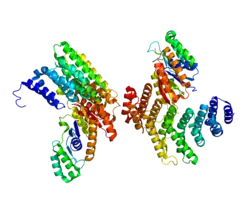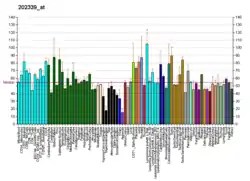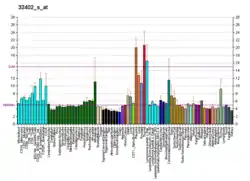| SYMPK | |||||||||||||||||||||||||||||||||||||||||||||||||||
|---|---|---|---|---|---|---|---|---|---|---|---|---|---|---|---|---|---|---|---|---|---|---|---|---|---|---|---|---|---|---|---|---|---|---|---|---|---|---|---|---|---|---|---|---|---|---|---|---|---|---|---|
 | |||||||||||||||||||||||||||||||||||||||||||||||||||
| |||||||||||||||||||||||||||||||||||||||||||||||||||
| Identifiers | |||||||||||||||||||||||||||||||||||||||||||||||||||
| Aliases | SYMPK, SPK, SYM, symplekin, Pta1, symplekin scaffold protein | ||||||||||||||||||||||||||||||||||||||||||||||||||
| External IDs | OMIM: 602388 MGI: 1915438 HomoloGene: 37969 GeneCards: SYMPK | ||||||||||||||||||||||||||||||||||||||||||||||||||
| |||||||||||||||||||||||||||||||||||||||||||||||||||
| |||||||||||||||||||||||||||||||||||||||||||||||||||
| |||||||||||||||||||||||||||||||||||||||||||||||||||
| |||||||||||||||||||||||||||||||||||||||||||||||||||
| |||||||||||||||||||||||||||||||||||||||||||||||||||
| Wikidata | |||||||||||||||||||||||||||||||||||||||||||||||||||
| |||||||||||||||||||||||||||||||||||||||||||||||||||
Symplekin is a protein that in humans is encoded by the SYMPK gene.[5][6]
Function
This gene encodes a nuclear protein that functions in the regulation of polyadenylation and promotes gene expression. The protein forms a high-molecular weight complex with components of the polyadenylation machinery. It is thought to serve as a scaffold for recruiting regulatory factors to the polyadenylation complex. It also participates in 3'-end maturation of histone mRNAs, which do not undergo polyadenylation. The protein also localizes to the cytoplasmic plaques of tight junctions in some cell types.[6]
Interactions
SYMPK has been shown to interact with CSTF2,[7] HSF1[8] and Oct4[9]
References
- 1 2 3 GRCh38: Ensembl release 89: ENSG00000125755 - Ensembl, May 2017
- 1 2 3 GRCm38: Ensembl release 89: ENSMUSG00000023118 - Ensembl, May 2017
- ↑ "Human PubMed Reference:". National Center for Biotechnology Information, U.S. National Library of Medicine.
- ↑ "Mouse PubMed Reference:". National Center for Biotechnology Information, U.S. National Library of Medicine.
- ↑ Ueki K, Ramaswamy S, Billings SJ, Mohrenweiser HW, Louis DN (May 1997). "Chromosomal localization to 19q13.3, partial genomic structure and 5' cDNA sequence of the human symplekin gene". Somatic Cell and Molecular Genetics. 23 (3): 229–31. doi:10.1007/BF02721375. PMID 9330635. S2CID 24956684.
- 1 2 "Entrez Gene: SYMPK symplekin".
- ↑ Takagaki Y, Manley JL (Mar 2000). "Complex protein interactions within the human polyadenylation machinery identify a novel component". Molecular and Cellular Biology. 20 (5): 1515–25. doi:10.1128/MCB.20.5.1515-1525.2000. PMC 85326. PMID 10669729.
- ↑ Xing H, Mayhew CN, Cullen KE, Park-Sarge OK, Sarge KD (Mar 2004). "HSF1 modulation of Hsp70 mRNA polyadenylation via interaction with symplekin". The Journal of Biological Chemistry. 279 (11): 10551–5. doi:10.1074/jbc.M311719200. PMID 14707147.
- ↑ Yu J, Lu W, Ge T, et al., (2019). "Interaction Between Sympk and Oct4 Promotes Mouse Embryonic Stem Cell Proliferation". STEM CELLS;37(6): 743-753 https://doi.org/10.1002/stem.2992
Further reading
- Keon BH, Schäfer S, Kuhn C, Grund C, Franke WW (Aug 1996). "Symplekin, a novel type of tight junction plaque protein". The Journal of Cell Biology. 134 (4): 1003–18. doi:10.1083/jcb.134.4.1003. PMC 2120966. PMID 8769423.
- Alwazzan M, Hamshere MG, Lennon GG, Brook JD (Jun 1998). "Six transcripts map within 200 kilobases of the myotonic dystrophy expanded repeat". Mammalian Genome. 9 (6): 485–7. doi:10.1007/s003359900804. PMID 9585442. S2CID 319161.
- Faber PW, Barnes GT, Srinidhi J, Chen J, Gusella JF, MacDonald ME (Sep 1998). "Huntingtin interacts with a family of WW domain proteins". Human Molecular Genetics. 7 (9): 1463–74. doi:10.1093/hmg/7.9.1463. PMID 9700202.
- Paffenholz R, Kuhn C, Grund C, Stehr S, Franke WW (Aug 1999). "The arm-repeat protein NPRAP (neurojungin) is a constituent of the plaques of the outer limiting zone in the retina, defining a novel type of adhering junction". Experimental Cell Research. 250 (2): 452–64. doi:10.1006/excr.1999.4534. PMID 10413599.
- Takagaki Y, Manley JL (Mar 2000). "Complex protein interactions within the human polyadenylation machinery identify a novel component". Molecular and Cellular Biology. 20 (5): 1515–25. doi:10.1128/MCB.20.5.1515-1525.2000. PMC 85326. PMID 10669729.
- Langbein L, Pape UF, Grund C, Kuhn C, Praetzel S, Moll I, Moll R, Franke WW (Aug 2003). "Tight junction-related structures in the absence of a lumen: occludin, claudins and tight junction plaque proteins in densely packed cell formations of stratified epithelia and squamous cell carcinomas". European Journal of Cell Biology. 82 (8): 385–400. doi:10.1078/0171-9335-00330. PMID 14533737.
- Xing H, Mayhew CN, Cullen KE, Park-Sarge OK, Sarge KD (Mar 2004). "HSF1 modulation of Hsp70 mRNA polyadenylation via interaction with symplekin". The Journal of Biological Chemistry. 279 (11): 10551–5. doi:10.1074/jbc.M311719200. PMID 14707147.
- Beausoleil SA, Jedrychowski M, Schwartz D, Elias JE, Villén J, Li J, Cohn MA, Cantley LC, Gygi SP (Aug 2004). "Large-scale characterization of HeLa cell nuclear phosphoproteins". Proceedings of the National Academy of Sciences of the United States of America. 101 (33): 12130–5. Bibcode:2004PNAS..10112130B. doi:10.1073/pnas.0404720101. PMC 514446. PMID 15302935.
- Barnard DC, Ryan K, Manley JL, Richter JD (Nov 2004). "Symplekin and xGLD-2 are required for CPEB-mediated cytoplasmic polyadenylation". Cell. 119 (5): 641–51. doi:10.1016/j.cell.2004.10.029. PMID 15550246. S2CID 8289230.
- Kolev NG, Steitz JA (Nov 2005). "Symplekin and multiple other polyadenylation factors participate in 3'-end maturation of histone mRNAs". Genes & Development. 19 (21): 2583–92. doi:10.1101/gad.1371105. PMC 1276732. PMID 16230528.
- Kimura K, Wakamatsu A, Suzuki Y, Ota T, Nishikawa T, Yamashita R, Yamamoto J, Sekine M, Tsuritani K, Wakaguri H, Ishii S, Sugiyama T, Saito K, Isono Y, Irie R, Kushida N, Yoneyama T, Otsuka R, Kanda K, Yokoi T, Kondo H, Wagatsuma M, Murakawa K, Ishida S, Ishibashi T, Takahashi-Fujii A, Tanase T, Nagai K, Kikuchi H, Nakai K, Isogai T, Sugano S (Jan 2006). "Diversification of transcriptional modulation: large-scale identification and characterization of putative alternative promoters of human genes". Genome Research. 16 (1): 55–65. doi:10.1101/gr.4039406. PMC 1356129. PMID 16344560.
- Kavanagh E, Buchert M, Tsapara A, Choquet A, Balda MS, Hollande F, Matter K (Dec 2006). "Functional interaction between the ZO-1-interacting transcription factor ZONAB/DbpA and the RNA processing factor symplekin" (PDF). Journal of Cell Science. 119 (Pt 24): 5098–105. doi:10.1242/jcs.03297. PMID 17158914. S2CID 8702837.
This article is issued from Wikipedia. The text is licensed under Creative Commons - Attribution - Sharealike. Additional terms may apply for the media files.





